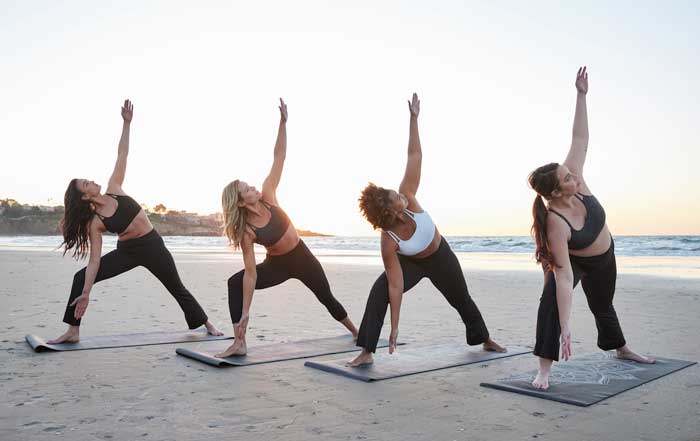The professional landscape in the United Kingdom continues to shift rapidly, shaped by hybrid work structures, high-pressure career environments, and increasing mental health awareness. As professionals juggle mounting deadlines, long commutes, and evolving job expectations, one aspect of life often sacrificed is personal health and fitness. This challenge has sparked an urgent demand for time-efficient and effective wellness solutions tailored for busy individuals.
Many office workers, entrepreneurs, and executives in the UK are now turning to innovative fitness programs that cater to their limited availability while ensuring they achieve tangible health outcomes. These programs are not merely about losing weight or toning muscles—they encompass mental clarity, energy optimization, stress reduction, and long-term physical sustainability.
With UK professionals spending an average of 40 to 60 hours per week on work-related tasks, finding a consistent time slot for health often feels impossible. However, thanks to modern fitness technologies, mobile accessibility, and scientifically designed routines, staying fit has become more achievable than ever—even for the most time-strapped individuals.
UK Professional Fitness Matcher
Find your perfect fitness program in 60 seconds
What's your biggest challenge with fitness?
What Makes a Fitness Program Ideal for Busy People?
Fitness programs designed for busy professionals share several defining traits. Firstly, they emphasize efficiency over duration—a 20-minute high-intensity workout that delivers cardiovascular and strength benefits can often replace an hour-long gym session. Secondly, flexibility is paramount. Whether it’s a quick workout at home, in the office, or while traveling, modern fitness solutions must fit seamlessly into the user’s lifestyle.
Moreover, accountability and expert guidance have become critical factors. The rise of virtual coaching, fitness apps with AI-powered personalization, and subscription-based platforms offering real-time feedback have redefined what fitness looks like for the working class. Beyond physical transformation, these programs often include nutrition advice, mindfulness exercises, and tools to track biometric improvements, supporting a holistic view of wellness.
Professionals today expect results without friction—and they expect it to be accessible from a smartphone or wearable device, anytime and anywhere. This shift in expectations has accelerated the growth of several standout programs in the UK fitness landscape.
Leading Fitness Programs for UK Professionals
1. Fiit – UK’s Digital Fitness Powerhouse
Fiit is one of the most celebrated digital fitness platforms in the UK. Known for its studio-quality classes and real-time performance tracking, Fiit has become a go-to solution for professionals who demand intensity and personalization from their training.
Offering a wide array of HIIT, strength, yoga, and mobility workouts, Fiit allows users to tailor sessions based on their goals and available time. With integration into smart TVs and wearables like the Apple Watch or Wahoo heart rate monitor, professionals can get coached virtually and track progress through a seamless interface.
Notably, Fiit sessions range from 10 to 40 minutes, allowing flexibility without compromising on impact. The platform is popular among urban professionals in cities like London, Manchester, and Edinburgh, who rely on its guided programs for their daily wellness boost.
To explore more on fitness routines, visit WellNewTime’s fitness section.
2. Peloton App UK – More Than Just a Bike
While Peloton originally gained fame through its high-end stationary bikes, the Peloton App UK offers far more than indoor cycling. With thousands of classes available—ranging from cardio, barre, pilates, strength, and stretching—the app has become a holistic fitness companion for busy Brits.
What makes Peloton particularly appealing is its schedule-friendly design. Users can filter workouts by time, difficulty, and instructor, making it easy to fit in a 15-minute core blast or a 20-minute guided run between meetings. The app also provides audio-only sessions, ideal for professionals who prefer working out during walks or lunch breaks.
Professionals in sectors like tech, finance, and media—especially those based in London's Canary Wharf and Shoreditch—have embraced Peloton as a wellness staple that travels with them across time zones and locations.
3. Joe Wicks (The Body Coach) – Fitness with a Personality
Few names in the UK health space carry as much weight as Joe Wicks, famously known as The Body Coach. His mobile app and training plans have helped countless busy professionals get fit using his signature blend of short HIIT sessions, motivational coaching, and meal planning.
The Body Coach App offers a structured, progressive fitness journey, including 20–25 minute daily workouts, which require minimal equipment. What makes it stand out is the emotional engagement Wicks brings to each session—users often cite his positivity and relatability as key motivators.
The app includes guided plans, recipes, shopping lists, and weekly check-ins, making it perfect for professionals who seek a trusted mentor and a holistic wellness experience, not just isolated workouts.
For tips on health and vitality, visit WellNewTime’s health section.
4. Gymbox Online – Urban Grit Meets Digital Convenience
Gymbox, an edgy, trend-setting fitness chain popular in London’s urban boroughs, has extended its rebellious energy to the online space. Its digital offering, Out the Box, includes on-demand workouts inspired by boxing, dance, strength, and conditioning.
This platform is a favorite for creative professionals and entrepreneurs who want visceral, engaging fitness experiences—not just repetitions and calories burned. Sessions range from 15 to 45 minutes, making them ideal for integrating into a flexible routine.
Professionals from the creative, advertising, and fashion industries—especially around Soho, Camden, and Shoreditch—frequently cite Gymbox as their go-to digital escape from daily stress.
To complement fitness with wellness strategies, explore WellNewTime’s lifestyle content.
5. Les Mills+ UK – Science-Backed Group Fitness, Anywhere
Les Mills+ (formerly Les Mills On Demand) brings the energy of global fitness classes to your screen, offering BODYCOMBAT™, BODYPUMP™, BODYBALANCE™, and more. These workouts are choreographed by fitness scientists and delivered by charismatic instructors.
The platform’s 30-minute express classes have proven popular among professionals who want intensity without the commute to a gym. With the ability to cast classes to a big screen or use mobile devices, Les Mills+ offers scalable workouts for living rooms, hotel spaces, or even office breakrooms.
It’s especially popular among corporate professionals and teachers, as the structure and scientific validation of each workout instill trust and ensure safety.
Fitness Programs Tailored for Specific Professional Lifestyles
The diversity of the UK's workforce means fitness solutions must cater to a wide array of routines, roles, and responsibilities. What works for a marketing executive in Bristol might not suit a healthcare shift worker in Birmingham or a stay-at-home consultant parent in Glasgow. Recognizing this, many fitness programs in the UK are now highly specialized, offering options that address the unique constraints of different lifestyles.
Fitness for Executives and High-Level Professionals
Executives often face relentless schedules filled with meetings, travel, and decision fatigue. Their fitness requirements revolve around stress management, core strength, cardiovascular health, and mental clarity.
One standout option is Ultimate Performance (UP Fitness), a results-driven personal training platform with studios in London, Manchester, and Leeds. Their remote coaching program delivers customized fitness plans, nutrition support, and 24/7 accountability from expert trainers. Sessions can be completed at home, in a hotel gym, or between meetings.
Learn more about Ultimate Performance
Additionally, apps like Future (available in the UK via iOS) offer elite-level personal coaching, where busy leaders are matched with professional trainers who build and adjust routines weekly via smartphone.
Executives interested in long-term health benefits may also explore WellNewTime’s business insights on wellness investment and performance.
Fitness for Shift Workers and Essential Professionals
Healthcare workers, transportation staff, and law enforcement professionals often work irregular hours. Their challenge lies in maintaining energy levels, managing physical strain, and preventing burnout.
The Centr app, founded by actor Chris Hemsworth, offers programs that cater to erratic schedules. With options like 5-minute meditations, 20-minute functional workouts, and 10-minute healthy meal recipes, Centr promotes recovery as much as fitness. This approach has proven especially popular among nurses and paramedics in the NHS system.
Another highly adaptable option is 7 Minute Workout by Johnson & Johnson, an evidence-based app featuring brief yet effective workouts that require no equipment. This is particularly beneficial for professionals with limited access to traditional gyms.
Busy workers exploring wellness recovery can also benefit from WellNewTime’s massage and relaxation resources, especially for relieving work-related tension.
Fitness for Parents Working from Home
With the UK seeing continued growth in remote working, many parents now juggle Zoom meetings, childcare, and house management—all in one setting. For them, the ideal fitness solution must be quiet, fast, space-efficient, and sometimes child-inclusive.
Yoga with Adriene, available free on YouTube and through the Find What Feels Good app, has become a mainstay in many UK households. Her gentle approach, paired with programs like "Yoga for Busy Moms" and "Office Yoga", allows caregivers to fit in wellness during nap times or after school drop-offs.
For something more dynamic, FitOn is a free app with celebrity trainers, real-time tracking, and customizable programs that include low-impact, postpartum, and family-friendly options.
Visit WellNewTime’s wellness page to explore additional holistic strategies for balancing family, work, and fitness.
Corporate Wellness Programs: A Cultural Shift in the UK
Employers in the UK are increasingly recognizing that a healthy workforce is a productive workforce. Corporate wellness initiatives are gaining traction, especially within sectors like finance, law, education, and tech. These programs not only aim to improve employee well-being but also to reduce absenteeism, boost morale, and support mental health.
Leading Corporate Wellness Platforms in the UK
Gympass UK is a corporate wellness platform that gives employees access to hundreds of gyms, studios, and digital programs, all under one subscription. It’s ideal for companies that want to offer flexible options while respecting individual preferences.
Unmind is another key player, focusing on mental well-being and resilience through a combination of psychology-based tools, guided meditations, and team engagement features. While not strictly a fitness tool, it complements physical programs to foster comprehensive employee health.
Several FTSE 100 companies now partner with ClassPass, allowing staff to access in-person classes and online sessions globally, making it suitable for hybrid teams and frequent travelers.
These organizational strategies reflect a growing awareness of how physical health correlates with performance, creativity, and retention—making it more than a perk, but rather an investment.
Learn more about business wellness trends in WellNewTime’s workplace coverage.
Integrating Nutrition, Mindfulness, and Ergonomics
Fitness is no longer viewed in isolation. Holistic health—which includes movement, nutrition, mental health, and daily ergonomics—is the preferred approach for modern professionals. Time-efficient fitness plans increasingly come bundled with meal tracking tools, guided meditations, and sleep optimization features.
Top Tools for Nutritional Support
The MyFitnessPal app remains the UK’s top nutritional tracker, with barcode scanning, meal plans, and integration into fitness platforms like Fitbit, Fiit, and Garmin. For those focused on sustainable food habits, the Lifesum app offers personalized meal guides based on diet type—vegan, keto, Mediterranean, and more.
Professionals with dietary restrictions or specific goals often seek consultation through online registered nutritionists, many of whom operate through platforms like ZOE or Nutritionist Resource.
Explore WellNewTime’s health features for additional insights into healthy eating and nutrition.
Mindfulness and Mental Resilience
Programs like Headspace for Work and Calm Business are widely adopted by professionals who recognize the role of stress reduction in achieving fitness and productivity goals. Even short daily breathing sessions can reduce cortisol levels and improve focus.
In the UK, NHS-backed initiatives have also pushed for greater access to mental fitness tools. Public sector workers and corporate teams now use integrated apps to deliver guided mindfulness alongside physical activity routines.
For environmental stress relief and life balance, check out WellNewTime’s environment section.
Ergonomic Health at the Workplace
Many fitness programs now incorporate ergonomic guidance, such as stretches for desk workers, posture correction exercises, and tools to manage screen fatigue.
The Desk Yogi app, for instance, offers short workplace-friendly fitness and mindfulness routines, while Ergotron provides home office accessories that promote active standing and motion throughout the workday.
Given that more than 9 million people in the UK suffer from back pain, these solutions are not just optional but critical for sustained wellness in digital-era jobs.
Visit WellNewTime’s lifestyle section to learn more about ergonomics and modern health.
The Role of Wearables and AI in UK Fitness Routines
One of the most significant advancements shaping fitness for busy professionals is the integration of wearable technology and artificial intelligence. In 2025, these tools are not just novelty items—they are central to how fitness is personalized, tracked, and maintained in real time.
Leading Wearable Devices for Busy Professionals
Smartwatches and fitness bands now do far more than count steps. Devices like the Apple Watch Series 9, Garmin Venu 3, and Whoop Strap 4.0 deliver detailed insights into heart rate variability, sleep cycles, recovery needs, and even stress indicators. These metrics are then synced with apps like Strava, Fiit, and Centr, enabling users to make informed decisions about when to push harder and when to rest.
For professionals aiming to maximize recovery and performance, wearable data provides objective evidence—a welcome shift from guesswork to data-driven strategy.
Learn more about health technology and performance at WellNewTime’s technology-forward fitness portal.
AI-Driven Personal Training: Smarter Coaching
Artificial intelligence is now embedded in many UK fitness platforms. Apps like Freeletics, Jefit, and Fitbod analyze user performance and automatically adapt workout intensity and structure based on previous sessions.
In the workplace wellness sphere, tools like Lumen provide metabolic readings through breath analysis and offer AI-personalized nutrition advice—a game-changer for professionals with specific performance or weight goals.
These innovations reduce decision fatigue, allowing users to focus purely on execution while the app adapts routines on the go. This level of intelligent responsiveness is invaluable for individuals juggling back-to-back tasks and minimal downtime.
For more on automation and health trends, explore WellNewTime’s world coverage.
In-Person vs Virtual: Which Is Better for Busy Schedules?
The debate between in-person and virtual training continues in 2025, though the lines have blurred with the rise of hybrid wellness models. While traditional gyms still offer the advantage of equipment variety and physical community, digital platforms have excelled at convenience, cost-efficiency, and personal customization.
Advantages of Virtual Programs
No commute required, saving time and reducing friction
Greater schedule flexibility, available 24/7
Broader access to global trainers and specialty workouts
Lower cost, especially for app-based subscriptions
Advantages of In-Person Training
Physical accountability and real-time correction
Hands-on coaching, particularly beneficial for injury prevention
Structured environments that reduce distractions
In cities like London, Birmingham, and Glasgow, fitness studios now blend both: offering live-streamed group classes, in-app progress tracking, and even AR-guided sessions that simulate in-person engagement. The modern UK professional is no longer forced to choose—hybrid models offer the best of both worlds.
Professionals can consult WellNewTime’s business and jobs sections to learn how companies are integrating hybrid fitness into workplace wellness packages.
Expert Insights: UK Professionals on Staying Fit
To illustrate the impact of tailored fitness programs, WellNewTime spoke with several professionals from across the UK who’ve managed to make health a consistent part of their routines.
Sophie Langford, a 35-year-old solicitor in Leeds, shared:"I used to think I needed to spend an hour at the gym to be healthy. But since discovering Fiit and tracking my heart rate with my Garmin, I’ve actually improved my stamina—and I only train 25 minutes a day."
Arun Mehta, a 42-year-old fintech executive based in London, added:"My Peloton app has become my coach and therapist. I ride in the mornings, stretch in the evenings, and sync everything with my Apple Watch. The data keeps me honest. I don’t need a gym anymore."
Dr. Hannah Price, a NHS frontline consultant in Manchester, noted:"I use the 7 Minute Workout app during breaks. It keeps me alert and grounded during shifts. It’s a lifesaver, literally and figuratively."
These testimonials reinforce a powerful message: when fitness is designed with empathy for time, lifestyle, and stress levels, it becomes sustainable.
To read more personal stories, visit WellNewTime’s news section.
The Future of Fitness for Professionals in the UK
As the boundaries between work, home, and health continue to evolve in the post-pandemic world, the future of fitness is set to become even more integrated into the daily flow of professional life.
We can expect increased adoption of:
AI wearables that auto-adjust workouts
Workplace fitness rooms with smart mirrors and VR trainers
Corporate subsidies for mental wellness subscriptions
Gamified fitness apps that reward movement with digital incentives
Moreover, the UK’s National Health Service is investing in preventive wellness technologies, aiming to reduce long-term health costs through early fitness intervention—a strategy that directly benefits overworked professionals.
Programs that combine accessibility, personalization, and science-backed routines will dominate the next decade, redefining what professional health and performance look like.
Final Thoughts
Staying fit as a busy professional in the United Kingdom is no longer about carving out hours or forcing rigid routines. It is about intelligently integrating wellness into the architecture of modern life. From short daily workouts and AI-powered coaching to ergonomic tools and mental health support, today’s fitness programs reflect a mature understanding of the professional experience.
As work patterns change, so must wellness strategies. By leveraging cutting-edge apps, wearables, and workplace partnerships, UK professionals are rewriting the narrative: health is no longer a luxury—it’s a strategy.
Published by WellNewTime – Empowering wellness through informed living.










